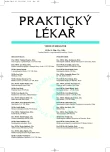Why and what kind of physical training is most effective for health and quality of life in older persons?
Authors:
M. Máček 1; J. Máčková 2; J. Radvanský 3
Authors‘ workplace:
Klinika rehabilitace, 2. LF UK Praha a FN Motol
1; Subkatedra tělovýchovného lékařství, IPVZ Praha
2; Klinika tělovýchovného lékařství, 2. LF UK Praha a FN Motol.
Přednosta doc. Paedr. Pavel Kolář
3
Published in:
Prakt. Lék. 2006; 86(6): 336-340
Category:
Of different specialties
Overview
In studies published in recent years was demonstrated, that one-sided preference of endurance training in older age was not able to satisfy all requirements for maintenance of the strength and endurance, necessary for a satisfactory quality of life. Sarcopenia and loss of strength are known to occur with age, but increasing age is not the main cause of sarcopenia. From the multifactorial sequelae is mostly accused the inactivity, combined with decreased energy expenditure, increased body fat, dyslipidaemia and reduced insulin sensitivity.
Resistance training in older adults increases power, reduces the difficulty of performing daily tasks, enhances energy expenditure and promotes participation on training and spontaneous physical activity. The effects of resistance training in older persons are different from these in younger, the increases of oxidative capacity and decrease of glycolytic ATP synthesis is probably cause by lower intensity of training.
Key words:
aging muscles, sarcopenia, resistance and endurance training
Labels
General practitioner for children and adolescents General practitioner for adultsArticle was published in
General Practitioner

2006 Issue 6
Most read in this issue
- The harmful effect of noise on the human organism
- Inhaled insulin
- Pulmonary embolism in the pneumology out-patient clinic
- Why and what kind of physical training is most effective for health and quality of life in older persons?
